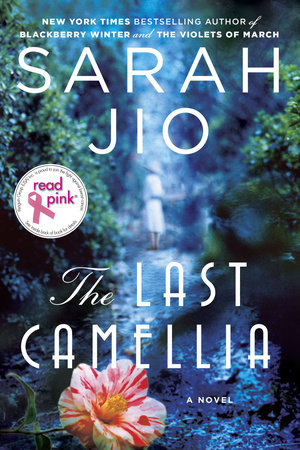Read Pink the Last Camellia Reader’s Guide
By Sarah Jio


INTRODUCTION
“Terrific…compelling…an intoxicating blend of mystery, history and romance, this book is hard to put down.” —Real Simple
On the eve of the Second World War, the last surviving specimen of a camellia plant known as the Middlebury Pink lies secreted away on an English country estate. Flora, an amateur American botanist, is contracted by an international ring of flower thieves to infiltrate the household and acquire the coveted bloom. Her search is at once brightened by new love and threatened by her discovery of a series of ghastly crimes.
More than half a century later, garden designer Addison takes up residence at the manor, now owned by the family of her husband, Rex. The couple’s shared passion for mysteries is fueled by the enchanting camellia orchard and an old gardener’s notebook. Yet its pages hint at dark acts ingeniously concealed. If the danger that Flora once faced remains very much alive, will Addison share her fate?
Sarah Jio is a frequent contributor to major magazines, including Real Simple, Glamour, Cooking Light, and Redbook, and is also the health and fitness blogger for Glamour.com. She lives in Seattle with her family.
Q. What inspired you to set the novel in an English manor? How is the setting essential to the story the novel is telling? You say in your author’s note that you “can still see the gardens of Livingston Manor” when you close your eyes. Do you always imagine the settings for your novels so vividly?
My late grandmother, Cecilia, had a fascination with British history, which must be genetic, as I’m the same way. When I began to create this story, I could think of no other setting as perfect for the camellia orchard than the English countryside. In my research, I learned that there are a few very rare camellias in the world, one of which is housed at a conservatory in London. It fascinated me to think of plants housed in protective settings like great art, and I envisioned the Middlebury Pink camellia in the novel to be just as lovely and rare as the prized specimens in real life. And, yes, as I wrote the novel, the camellia orchard was very vivid in my mind. I loved spending time there (in my imagination) while working on the book. I have a very active imagination, so I tend to see all of my stories in this way, playing out in my mind like a film.
Q. Your other novels also follow two storylines: one set in the past, and one in the present. The female protagonists of each — in this case, Flora and Addison — always seem to have such a strong connection to one another. How do you create this kind of kinship between two characters who never meet? Have you ever felt a similar kind of draw to someone you’ve never met?
It’s a concept I think about a lot, especially since there are many people in history who I have never met, and yet feel a kinship to. I think that looking to the past is so important-to learn about ourselves, to improve, to be inspired. I love seeing that happen (well, making that happen) in my books. There are so many great women in history that I am fond of. In particular, at this moment, I’m fascinated by the life of Margaret Wise Brown, the late author of hundreds of beloved children’s books, including Goodnight Moon. Margaret wrote of a life with endless (and sometimes overwhelming) creativity. I can relate to that endless stream of ideas. But what’s maddening is not having endless time to give each their attention, and I think Margaret would get this pressure. I think we’d have great conversations about it, which is why my sixth novel, out in 2014, is inspired, in part, by her life and legacy.
Q. You note in the preface that camellias have a quiet, unassuming beauty — they’re not the flashiest flowers in the garden. Why are Flora, Addison, and Lady Anna all so enchanted by them? What do you think the orchard comes to symbolize for these women? Do you associate camellias with a sense of peace in your own life?
Camellias are beautiful, but in such an understated way. For the women in my novel, I think camellias came to symbolize peace and calm, safety and protection-elements that all of the women were in search of. I suppose this is true of myself, too. A camellia stood at attention on either side of my childhood home, in my mother’s garden. These special flowering trees watched as I passed through the door everyday. They saw me grow from a child to a young woman. And though my parents sold the home a few years ago, those camellias will always stay with me, in my heart.
Just for joining you’ll get personalized recommendations on your dashboard daily and features only for members.
Find Out More Join Now Sign In